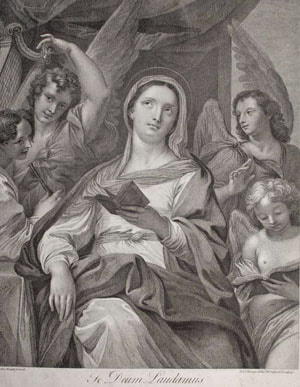
Sir Robert Strange (1721-1792)
Strange was born on Orkney. Following a classical education, he moved to Edinburgh and an apprenticeship with the engraver Richard Cooper (1701-1764).
Redgrave gives a flavour of Strange’s early years, ‘He first began business himself as an engraver in that city [Edinburgh] and had a respectable position there when…it was occupied by the Young Pretender [Charles Edward Stuart] and his troops in 1745. He joined the Jacobite side, and was appointed engraver to Prince Charles, a half-length portrait of whom, bearing the initials ‘C.P.R. and R. Strange, sculpt.’ gained him a great reputation…He is reputed to have fought in the ranks at Culloden, and after the loss of the battle to have escaped to Paris. Here he studied under Le Bas, and in 1751 returned to London, where he established himself, and was recognised as an engraver of great eminence.’
On the accession of George III, Strange was offered the commission to engrave portraits of the King and Lord Bute, the Prime Minister. This he refused, offending the King and promoting, in the monarch’s eyes, the work of Francesco Bartolozzi (1727-1815).
In the course of his career, Strange travelled widely through Europe, becoming a member the academies of Florence, Bologna, Palma and Paris in the process. Notably, he disapproved of the foundation of the Royal Academy and, as he saw it, its negligent attitude to engravers.
Strange is known for his engravings after old master painters (such as Te Deum Laudamus after Carlo Maratti, above right) and for his 1787 engraving after Benjamin West’s Apotheosis of Princes Octavius and Alfred, for which the King gave him a knighthood.
Collections
British Museum, London
Metropolitan Museum, New York
National Galleries of Scotland
National Portrait Gallery, London
Royal Collection Trust
Victoria and Albert Museum, London
Literature
Gray, B (1937), The English Print, Adam and Charles Black
Hind, A M (1963 reprint), A History of Engraving and Etching, Dover Publications
Mackenzie, I (1988), British Prints, Antique Collectors’ Club
Redgrave, S (1970 reprint), A Dictionary of Artists of the English School, Kingsmead Reprints
Williamson, G C Ed. (1904), Bryan’s Dictionary of Painters and Engravers, George Bell and Sons
Strange was born on Orkney. Following a classical education, he moved to Edinburgh and an apprenticeship with the engraver Richard Cooper (1701-1764).
Redgrave gives a flavour of Strange’s early years, ‘He first began business himself as an engraver in that city [Edinburgh] and had a respectable position there when…it was occupied by the Young Pretender [Charles Edward Stuart] and his troops in 1745. He joined the Jacobite side, and was appointed engraver to Prince Charles, a half-length portrait of whom, bearing the initials ‘C.P.R. and R. Strange, sculpt.’ gained him a great reputation…He is reputed to have fought in the ranks at Culloden, and after the loss of the battle to have escaped to Paris. Here he studied under Le Bas, and in 1751 returned to London, where he established himself, and was recognised as an engraver of great eminence.’
On the accession of George III, Strange was offered the commission to engrave portraits of the King and Lord Bute, the Prime Minister. This he refused, offending the King and promoting, in the monarch’s eyes, the work of Francesco Bartolozzi (1727-1815).
In the course of his career, Strange travelled widely through Europe, becoming a member the academies of Florence, Bologna, Palma and Paris in the process. Notably, he disapproved of the foundation of the Royal Academy and, as he saw it, its negligent attitude to engravers.
Strange is known for his engravings after old master painters (such as Te Deum Laudamus after Carlo Maratti, above right) and for his 1787 engraving after Benjamin West’s Apotheosis of Princes Octavius and Alfred, for which the King gave him a knighthood.
Collections
British Museum, London
Metropolitan Museum, New York
National Galleries of Scotland
National Portrait Gallery, London
Royal Collection Trust
Victoria and Albert Museum, London
Literature
Gray, B (1937), The English Print, Adam and Charles Black
Hind, A M (1963 reprint), A History of Engraving and Etching, Dover Publications
Mackenzie, I (1988), British Prints, Antique Collectors’ Club
Redgrave, S (1970 reprint), A Dictionary of Artists of the English School, Kingsmead Reprints
Williamson, G C Ed. (1904), Bryan’s Dictionary of Painters and Engravers, George Bell and Sons
Our full selection of antique prints can be viewed here.